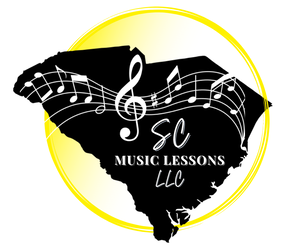"Three things are necessary for happiness: a faithful wife, a well-padded chair, and a harp well-tuned." - An Irish TriadWe are grateful to have Lowcountry instructors, Kim (celtic harpist) and Mallory (pedal harpist) on our team! In this blog post, they have shared information that they hope will help you choose which instrument is the best fit for you. As always, feel free to contact us if you have additional questions. We are here to help! Definition:Celtic Harp (Folk Harp or Lever Harp): "A smaller harp with wire and nylon strings, used in the folk and early music of Scotland and Ireland." Pedal Harp (Concert Harp or Classical Harp): "A larger and technologically modern harp, designed primarily for use in art music." "Musicians who play Celtic harps are called "harpers" while those who play Pedal harps are called "harpists". The word “harp” comes from Old Norse, Anglo-Saxon, or Old German words meaning “to pluck”. Appearance:
In these videos from Lowcountry Pianist & Company LLC, you can see some of the differences in appearance of each instrument. Pedal harps are larger than celtic harps. Additionally, changing the pitch (making strings sound lower or higher) is controlled by pedals on the pedal harp (located at the base of the instrument) while the celtic harp uses levers (located at the top of the instrument). For example, imagine a piano keyboard; there are white and black strings. In the olden times only the white notes could be plucked unless the harper re-tuned the string for a certain song, whereas now the harper / harpists can change their levers or pedals and essentially then have the black keys on the piano available also. History:Celtic Harp The earliest representations of the Celtic harps were found sculpted on stone in Scotland dating from the eighth or ninth century. By the year 1000, early forms of the Celtic harp were widespread all over Ireland, Wales and Scotland. Harpers abounded, and the music of the harp was important to the people. In ancient times in Scotland, harpers were the counselors of kings and were given the chair of honor, titles and wealth for their services. They were considered second in rank to the clan bard or filidh... These benefits were not inherited by their children but went to the best harper. In Ireland, the harpers were consulted before going to war and often in both Ireland and Scotland, led the troops to battle with harp... It’s hard to imagine that the harp could be seen as, or sound like, an instrument of war, but it’s important to remember that with all wire strings, the sound would ring out and carry across the hills. Harpers and bards told the stories of history, and the people. Music accompanied everything in the Scots and Irish life: birth, work, death, celebrations, mourning. Ireland’s National symbol, the harp on the Guinness bottles, and on the coins is called the “Brian Boru” Harp. As the official emblem of Ireland it also appears on the Presidential seal, every Irish passport, and is used in the coat-of-arms of the National University of Ireland and is based on a real harp that was built in 1220, and is now housed at Trinity College in Dublin. Since Celtic harp music was an oral tradition, and not written down, until fairly recently it was believed most of the music to be almost entirely lost. [Thankfully] there has been a revival of the music and with Celtic Harpers themselves. Musicians who perform and teach about this ancient instrument help to keep this beautiful and historical music alive!
Pedal Harp The first mention of the harp is dated back to Biblical times. King Saul even called upon David to play the harp for him and "... Saul would then be relieved, feel better, and the evil spirit would leave him." (1 Samuel 16:23) The pedal harp really began developing in the 18th century as musical styles were evolving. Learn more about the pedal harp's history on Britannica (click here). Styles of Music:Celtic Harp Obviously ancient music (from 1600's) from Ireland, Scotland, Britain and Wales sounds right at home on the Celtic harp because it is! However, with the fairly recent addition of levers on Celtic harps, all kinds of music are possible and can be adapted for the Celtic harp. Classical, meditation, therapy, pop, folk, romantic, even jazz and rock are now adapted and are played on Celtic harp. Pedal Harp The pedal harp originally was designed for art music and other classical selections, but many genres can be played on the harp, much like a piano. Harp and piano music is very similar! How to Play:Celtic Harp Since Celtic harps can be different sizes, the way you hold one depends on the size. Celtic harps range in strings from 22 strings (smaller lap harps) to 36 (floor harps). A floor harp is on the floor and the harper rests the harp lightly (it just balances, not pushes) on the right shoulder and the left hand plays the lower notes while the right hand plays the higher, melody line. Lap harps can have "knee boards" screwed on to them so you sit with it resting on your knees and the harp in your lap, and a lap harp can also have a strap across it so you strap it to yourself much like a guitar, and can walk around and play it this way. However, I [Kim] like to play my lap harp propped on a stool so it is still played much like a floor harp. Pedal Harp A full size (grand) pedal harp has 48 strings and 7 pedals for each note of the musical alphabet (A-G). The bottom strings are made of wire, and the rest are made of gut. There are about 2,000 moving parts inside the harp. To play, you sit down and pull the harp back on your right shoulder and pluck the strings. Cost:Celtic Harp All wooden harps are handmade. They may come from a large maker, but each is unique. Brand new Celtic harps range in price from a few hundred dollars to $9,000. Obviously smaller harps cost less. The quality of harp changes price, and material the harp is made of. There are some harps (called harpsicles) that are a fiber material, and these will be less expensive. When you add levers on all strings [or only a couple of the strings] it changes the price. I would recommend buying a used harp (there are several very reputable harp journals with classifieds where private individuals sell their harps, or large harp stores also sell used). Another possibility is buying from at least one maker of harps that I know of who does a layaway plan, but you get the harp first and pay them monthly, interest free. Since every harp sounds slightly different, it's important to listen to different brands, sizes, kinds, etc. and people playing them. If you live near a store that sells them, this is wonderful of course, but since it's just not possible for many people to go to a harp "store" in their local area, you may need to travel to a city that has a store that sells them, or trust what you hear online. Pedal Harp New pedal harps range from around $10,000 - $25,000 and above, depending on the size and design of the harp (gold harps cost above the $30,000 range). Lyon & Healy is one of the best and one of the only harp manufacturers, based out of Chicago, IL. There are other smaller websites that offer used harps, although Lyon & Healy does too. In conclusion...We hope that this overview and comparison of celtic vs. pedal harps has been helpful as you decide which instrument is the right fit for you! Mallory loves how the harp is an "unique" instrument that is not seen often and Kim loves how playing the harp is "soothing and relaxing." Additionally, Kim shared how she "feels connected to a deep history and past that [she is] keeping alive." Kim and Mallory can't wait to share their knowledge with more SC Music Lessons students!
Learn more: www.scmusiclessons.com/kim www.scmusiclessons.com/mallory Contact Us: www.scmusiclessons.com/contact
0 Comments
Leave a Reply. |
|||||||||
CONTACT
Holly Slice, Owner
Email: [email protected]
Phone: 843-310-1083
Visit Our Sister Site:
Lowcountry Pianist & Company LLC
Email: [email protected]
Phone: 843-310-1083
Visit Our Sister Site:
Lowcountry Pianist & Company LLC
LEGAL
© 2024 SC Music Lessons LLC
All Rights Reserved.
All Rights Reserved.


 RSS Feed
RSS Feed